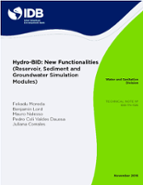Hydro-BID: New Functionalities (Reservoir, Sediment and Groundwater Simulation Modules)
Date
Nov 2016
The Inter-American Development Bank (IDB) provides financial and technicalsupport for infrastructure projects in water and sanitation, irrigation, flood control, transport, and energy, and for development projects in agriculture, urban systems, and natural resources. Many of these projects depend upon water resources and may be affected negatively by climate change and other developments that alter water availability, such as population growth and shifts in land use associated with urbanization, industrial growth, and agricultural practices. Assessing the potential for future changes in water availability is an important step toward ensuring that infrastructure and other development projects meet their operational, financial, and economic goals. It is also important to examine the implications of such projects for the future allocation of available water among competing users and uses to mitigate potential conflict and to ensure such projects are consistent with long-term regional development plans and preservation of essential ecosystem services. As part of its commitment to help member countries adapt to climate change, the IDB is sponsoring work to develop and apply the Regional Water Resources Simulation Model for Latin America and the Caribbean, an integrated suite of watershed modeling tools known as Hydro-BID. Hydro-BID is a highly scalable modeling system that includes hydrology and climate analysis modules to estimate the availability of surface water (stream flows) at the regional, basin, and sub-basin scales. The system includes modules for incorporating the effects of groundwater and reservoirs on surface water flows and for estimating sediment loading. Data produced by Hydro-BID are useful for water balance analysis, water allocation decisions, and economic analysis and decision support tools to help decision-makers make informed choices among alternative designs for infrastructure
projects and alternative policies for water resources management. IDB sponsored the development of Hydro-BID and provides the software and
basic training free of charge to authorized users; see hydrobidlac.org. The system was developed by RTI International as an adaptation of RTI's proprietary WaterFALL® modeling software, based on over 30 years of experience developing and using the U.S. National Hydrography Dataset (NHDPlus) in support to the U.S. Geological Survey and the U.S. Environmental Protection Agency. In Phase I of this effort, RTI prepared a working version of Hydro-BID that includes: (1) the Analytical Hydrography Dataset for Latin America and the Caribbean (LAC AHD), a digital representation of 229,300 catchments in Central America, South America, and the Caribbean with their corresponding topography, river, and stream segments; (2) a geographic information system (GIS)-based navigation tool to browse AHD catchments and streams with the capability of navigating upstream and downstream; (3) a user interface for specifying
the area and period to be modeled and the period and location for which water availability will be simulated; (4) a climate data interface to obtain rainfall and temperature inputs for the area and period of interest; (5) a rainfall-runoff model based on the Generalized Watershed Loading Factor (GWLF) formulation; and (6) a routing scheme for quantifying time of travel and cumulative flow estimates across downstream catchments. Hydro-BID generates output in the form of daily time series of flow estimates for the selected location and period. The output can be summarized as a monthly time series at the user's discretion. In Phase II of this effort, RTI has prepared an updated version of Hydro-BID that includes (1) improvements to the user interface; (2) a module to simulate the effect of reservoirs on downstream flows; (3) a module to link Hydro-BID and groundwater models developed with MODFLOW and incorporate water exchanges between groundwater and surface water compartments into the simulation of sur
projects and alternative policies for water resources management. IDB sponsored the development of Hydro-BID and provides the software and
basic training free of charge to authorized users; see hydrobidlac.org. The system was developed by RTI International as an adaptation of RTI's proprietary WaterFALL® modeling software, based on over 30 years of experience developing and using the U.S. National Hydrography Dataset (NHDPlus) in support to the U.S. Geological Survey and the U.S. Environmental Protection Agency. In Phase I of this effort, RTI prepared a working version of Hydro-BID that includes: (1) the Analytical Hydrography Dataset for Latin America and the Caribbean (LAC AHD), a digital representation of 229,300 catchments in Central America, South America, and the Caribbean with their corresponding topography, river, and stream segments; (2) a geographic information system (GIS)-based navigation tool to browse AHD catchments and streams with the capability of navigating upstream and downstream; (3) a user interface for specifying
the area and period to be modeled and the period and location for which water availability will be simulated; (4) a climate data interface to obtain rainfall and temperature inputs for the area and period of interest; (5) a rainfall-runoff model based on the Generalized Watershed Loading Factor (GWLF) formulation; and (6) a routing scheme for quantifying time of travel and cumulative flow estimates across downstream catchments. Hydro-BID generates output in the form of daily time series of flow estimates for the selected location and period. The output can be summarized as a monthly time series at the user's discretion. In Phase II of this effort, RTI has prepared an updated version of Hydro-BID that includes (1) improvements to the user interface; (2) a module to simulate the effect of reservoirs on downstream flows; (3) a module to link Hydro-BID and groundwater models developed with MODFLOW and incorporate water exchanges between groundwater and surface water compartments into the simulation of sur




